Issue : 1 Article : 6
Tank Ecosystem Services for Poverty Alleviation - A potential landscape with traditional biodiversity
A. Gurunathan , Director, Tata-Dhan Academy, tatadhanacademy@dhan.org
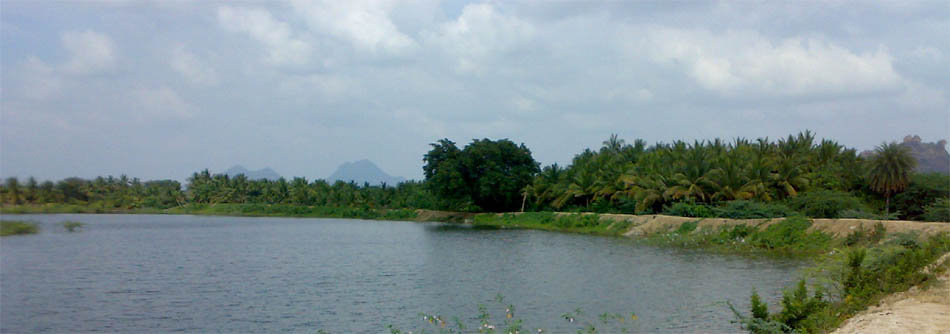
PreambleSmall, medium and big tanks (earthen bunded small storage reservoirs formed in the natural depressions of the land) have existed for many centuries, most of them in the semi-arid regions of South East Asia, because of the rolling topography and distinctive climate – intense monsoons followed by protracted droughts. In India alone, there are about 270,000 such tanks. These tanks are water harvesting structures, ingeniously designed by ancient native rulers and chieftains to meet the water needs of people and their cattle throughout the year, by capturing the intermittent heavy spells of monsoon rains received only for about 45 days in a year. Many of these tanks are linked as chains so that the surplus of the upper tank flows down into the lower one, adding synergy to the process of water harvesting and use. Quite a few tanks get supplemental supply of water from reservoirs or rivers through diversion channels, in addition to the rain water received from their own catchment areas; they are known as system tanks and store water for a larger period than rainfed tanks. In addition to these, there are thousands of domestic ponds formed by village communities as well as by some individuals. Tanks and ponds are important to the rural masses as they promote their health, livelihood and economic prospects. In accordance with the proceedings of the Ramsar Convention, such tanks and ponds are classified under “man-made inland-wetland ecosystem” based on their origin, vegetation, nutrient status and thermal characteristics. Although these water harvesting systems provide multiple services, they are valued mainly for their agricultural, domestic and livestock uses. The various services rendered by the tank ecosystem are as follows.
Even while demands for tank ecosytem services are growing, human actions are at the same time diminishing the capability of the tank ecosystem. One of the reasons for this could be that people are unaware of important ecological services other than the overt economical services provided by the tank ecosystems. This may probably be due to the absence of relevant research to bring out the values of ecosystem services holistically. It will be pertinent here to focus on the following quote. Because National Accounts are based on financial transactions, they account nothing for Nature, to which we don’t owe anything in terms of payments but to which we owe everything in terms of livelihood. - Bertrand de Jouvenel, 1968 |
|||
Tanks and BiodiversityIn varied context such as rural, coastal and tribal, the tank complex comprising tank bed, tank bund and foreshore are endowed with rich flora and fauna as well as migratory birds during the winter season. Fauna and floraTank bund, an earthern embankment across the slope to harvest water, houses many traditional varieties of trees such as Palmyarah, Tamarind, Banyan, Neem and other native species and wild herbs, creepers, etc. The trees fetch revenue to the village-level panchayat on regular periodicity; once in three years, they are auctioned for firewood, fuel for the brick kilns. Tanks during monsoon season with freshwater ecosystems become the habitat for many freshwater fauna including larva, mosquito eggs, fish varieties, frogs, etc. The food chain within freshwater system makes the environment green and lush. | |||
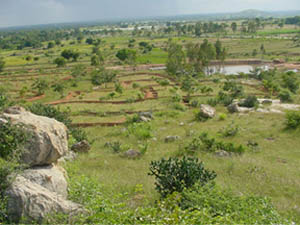 |
Crop diversityIn the command area of tanks, farmers cultivate food crops such as cereals namely paddy during the monsoon followed by pulses, oilseeds and fodder as catch crops. Command area serves as habitat formany birds and flies. |
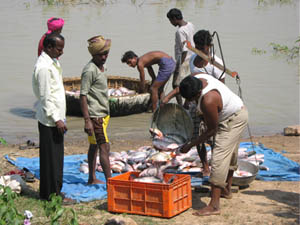 |
Tanks and inland fisheriesSince the tanks hold water for 4 to 6 months, the village community takes up pisciculture activities, as the fresh water ecosystem nurtures the growth of fishes and fetches the community good price when they auction the catch at the time of less water storage in tanks. The villagers use some of these fishes for their own consumption. |
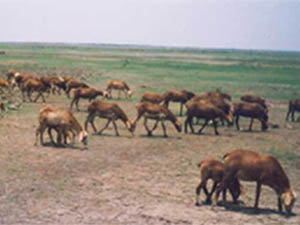 |
Tanks and grazingRehabilitation of tanks is followed by foreshore plantation and grasses are grown under the trees and bunds. to be used by the livestock as grazing land. As such in Tamil Nadu state, there is no category under land use pattern for grazing lands; only the tanks provide source for grazing immediately after monsoon season. |
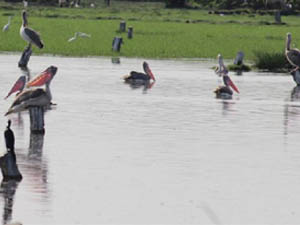 |
Tanks and bird sanctuaryTrees for shelter and availability of sufficient feed in the water make the tanks a better place for residing of birds. On the banks of many south Indian tanks, bird sanctuaries are situated; for example, Vedandangal in Kanchipuram District, Kudakulam in Tirunelveli District and Chitrakudi tank in Ramanathapuram District serve as bird sanctuaries. The community even now preserves the sanctuaries by deputing their own watch and ward and imposes social norms such as ban on fire crackers, hunting practices, etc. |
DHAN Foundation‘s Interventions in Restoring Tank EcosystemStarted as an action research project in 1992, the Tank-fed Agriculture Programme of DHAN Foundation (DHAN) has expanded its approach of working on isolated tanks to tank-based watersheds, reviving chains of tanks in minor river basins to multiply the impact of the renovation and restorationactivities. Over these years, farmers’ federations have undertaken conservation and development of over 3000 small-scale water resources with voluntary labour and contribution; and in the process, they have procured water for more than 200,000 hectares. In the process, DHAN has also evolved scalable models for inland fisheries development, creation of drinking water ponds, as well as low-cost and household-level water treatment methods. DHAN has made an institutional arrangement in the form of endowment funds at each Tank Farmers’ Association for the sustainability of the association and future maintenance of tanks. DHAN’s hydrologically based community institution model has been adopted in the Repair, Renovation and Rehabilitation Guidelines of Ministry of Water Resources. Besides, DHAN is one of the institutional members of World Water Council and Global Water Partnership. It has been inducted into the advisory group for National Water Academy, Pune and National Institute of Hydrology for Hard Rock Areas, Belgaum. DHAN has promoted the Council for Conservation of Small-Scale Water Resources. It comprises eminent thinkers and practitioners, who propagate and promote the conservation and development of small-scale irrigation systems in South India. This council engages in periodic interactions with policy makers, planners, administrators and bureaucrats. It also reflects the opinion of the people at the grassroots on matters related to small-scale irrigation systems through the media. Through various tools, the council helps to shape government policies related to this sector. |
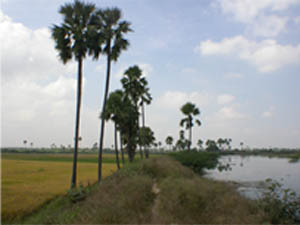 |
||
Challenges Faced by Tank EcosystemThe decline in community management poses a big threat to agricultural biodiversity in the tank ecosystem. In the absence of pro-community policies on preservation of tanks and their biodiversity, large-scale degradation occurs and large number of tanks are getting decimated. In the context of the climate change scenario, tanks are a potential source of water storage to impound unprecedented rains and summer rains. Concerted advocacy efforts are needed for creating enabling environment for reviving community mangement of tanks and for ensuring their sustenance as a vibrant agricultural ecosystem. |
|||
